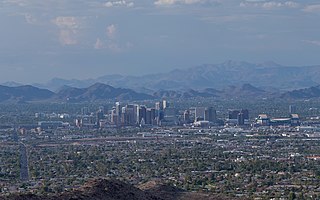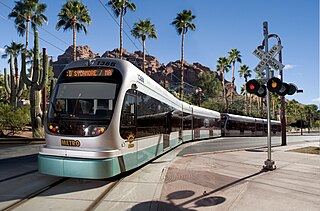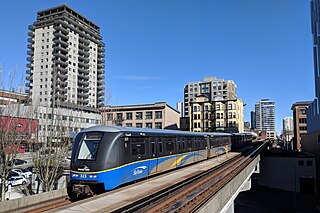
The Los Angeles County Metropolitan Transportation Authority (LACMTA), branded as Metro, is the county agency that plans, operates, and coordinates funding for most of the public transportation system in Los Angeles County, California, the most populated county in the United States.

The Phoenix metropolitan area, also known as the Valley of the Sun, the Salt River Valley, metro Phoenix, or The Valley, is the largest metropolitan statistical area in the Southwestern United States, with its largest principal city being the city of Phoenix. It includes much of central Arizona. The United States Office of Management and Budget designates the area as the Phoenix–Mesa–Chandler Metropolitan Statistical Area (MSA), defining it as Maricopa and Pinal counties. It anchors the Arizona Sun Corridor megaregion along with the second-most populous metropolitan area in the state, the Tucson metropolitan area. The gross domestic product of the Phoenix metropolitan area was $255 billion in 2018, 16th highest amongst metro areas in the United States.

The Downtown Seattle Transit Tunnel (DSTT), also referred to as the Metro Bus Tunnel, is a 1.3-mile-long (2.1 km) pair of public transit tunnels in Seattle, Washington, United States. The double-track tunnel and its four stations serve Link light rail trains on the 1 Line as it travels through Downtown Seattle. It runs west under Pine Street from 9th Avenue to 3rd Avenue, and south under 3rd Avenue to South Jackson Street. 1 Line trains continue north from the tunnel to Northgate station and south through the Rainier Valley past Seattle–Tacoma International Airport to Angle Lake station as part of Sound Transit's light rail network.

The B Line is a fully underground 14.7 mi (23.7 km) rapid transit line operating in Los Angeles, running between North Hollywood and Downtown Los Angeles. It is one of six lines in the Los Angeles Metro Rail system, operated by the Los Angeles County Metropolitan Transportation Authority. Built in four stages between 1986 and 2000, the line cost $4.5 billion.
The Valley Metro Regional Public Transportation Authority, more popularly known as Valley Metro, is the unified public brand of the regional transit system for the Phoenix metropolitan area. Within the system, it is divided between Valley Metro Bus, which runs all bus operations, Valley Metro Rail, which is responsible for light rail and streetcar operations in the Valley. In 2023, the combined bus and rail system had a ridership of 36,374,000, or about 122,500 per weekday as of the fourth quarter of 2023.

The 1 Line, formerly Central Link, is a light rail line in Seattle, Washington, United States, and part of Sound Transit's Link light rail system. It serves 19 stations in the cities of Seattle, SeaTac, and Tukwila, traveling nearly 25 miles (40 km) between Northgate and Angle Lake stations. The line connects the University District, Downtown Seattle, the Rainier Valley, and Seattle–Tacoma International Airport. The 1 Line carried over 26 million total passengers in 2023, with an average of nearly 80,000 daily passengers on weekdays. It runs for 20 hours per day on weekdays and Saturdays, with headways of up to six minutes during peak hours, and reduced 18-hour service on Sundays and holidays.

The Baltimore Light RailLink is a light rail system serving Baltimore, Maryland, United States, and its northern and southern suburbs. It is operated by the Maryland Transit Administration. In downtown Baltimore, it uses city streets. Outside the central portions of the city, the line is built on private rights-of-way, mostly from the defunct Northern Central Railway, Baltimore and Annapolis Railroad and Washington, Baltimore and Annapolis Electric Railway. The system had a ridership of 3,546,300, or about 12,500 per weekday, as of the fourth quarter of 2023.

Edmonton Light Rail Transit, commonly referred to as the LRT, is a light rail system in Edmonton, Alberta. Part of the Edmonton Transit Service (ETS), the system has 29 stations on three lines and 37.4 km (23.2 mi) of track. As of 2018, it was number seven on a list of the busiest light rail transit systems in North America, with over 113,000 daily weekday riders.

Valley Metro Rail is a 29.8-mile (48 km) light rail system serving the cities of Phoenix, Tempe, and Mesa in Arizona, USA. The network, which is part of the Valley Metro public transit system, began operations on December 27, 2008. In 2023, the system had a ridership of 10,797,600, or about 33,000 per weekday as of the fourth quarter of 2023.
The Bottineau LRT is a proposed light rail line extension in the Minneapolis – Saint Paul Metro area, projected to run northwest from Target Field station in downtown Minneapolis along County Road 81 to Brooklyn Park.

The East Link Extension, also known as the 2 Line, is a future light rail line serving the Eastside region of the Seattle metropolitan area in the U.S. state of Washington. It will be part of Sound Transit's Link light rail system, running 18 miles (29 km) from west to east and serving 12 stations in Downtown Seattle, Mercer Island, Bellevue, and Redmond. The first section of the 2 Line, between South Bellevue and Redmond Technology stations, is scheduled to open on April 27, 2024. It is planned to be followed in 2025 by an extension east to Downtown Redmond and west to Seattle, where it will continue into the Downtown Seattle Transit Tunnel and share stations with the 1 Line through to Lynnwood City Center station.

International District/Chinatown station is a light rail station that is part of the Downtown Seattle Transit Tunnel in Seattle, Washington, United States. The station is located at the tunnel's south end, at 5th Avenue South and South Jackson Street in the Chinatown-International District neighborhood, and is served by the 1 Line of Sound Transit's Link light rail system. The station is located adjacent to Sound Transit headquarters at Union Station, as well as intermodal connections to Amtrak and Sounder commuter rail at King Street Station and the First Hill Streetcar.

Westlake station is a light rail station that is part of the Downtown Seattle Transit Tunnel in Seattle, Washington, United States. The station is located under Pine Street between 3rd and 6th avenues in Downtown Seattle, near Westlake Center and Westlake Park. It is served by the 1 Line, part of Sound Transit's Link light rail system, and also connected above ground by buses at several stops, the South Lake Union Streetcar, and the Seattle Center Monorail.

The Seattle Streetcar is a system of two modern streetcar lines operating in the city of Seattle, Washington. The South Lake Union line opened first in 2007 and was followed by the First Hill line in 2016. The two lines are unconnected, but share similar characteristics: frequent service, station amenities, and vehicles. Streetcars typically arrive every 10–15 minutes most of the day, except late at night. The streetcar lines are owned by the Seattle Department of Transportation and operated by King County Metro. The system carried 1,326,500 passengers in 2023.

Valley Metro Bus is a transit bus system for public transport in Maricopa County, Arizona, United States. In 2023, the system had a ridership of 24,215,700, or about 85,000 per weekday as of the fourth quarter of 2023. Buses are operated by private companies contracted by Valley Metro and the City of Phoenix. Service currently operates throughout the broader Phoenix Metropolitan Area. All buses have wheelchair ramps or lifts, and except for paratransit vehicles, all buses have bike racks.

Metro is a transit network in Minnesota serving the cities of Minneapolis and Saint Paul. It also provides service to some suburban areas. As of 2022, the system consists of two light rail lines and five bus rapid transit (BRT) lines all of which are operated by the local public transit company: Metro Transit. The five lines connect Downtown Minneapolis and St Paul with the Bloomington, Minneapolis-St Paul International Airport, Roseville, Richfield, Burnsville and Brooklyn Center.

The Tempe Streetcar, referred to as the Streetcar Line on regional transit maps, is a streetcar extension of Phoenix's Valley Metro Rail system. Construction began in 2017, and the line opened for service on May 20, 2022. It serves 14 stops across three miles of track serving various parts of the city's downtown, as well as the Tempe campus of Arizona State University, with the Valley Metro Rail main line.

Urban rail transit in Canada encompasses a broad range of rail mass transit systems, including commuter rail, rapid transit, light rail, and streetcar systems.















